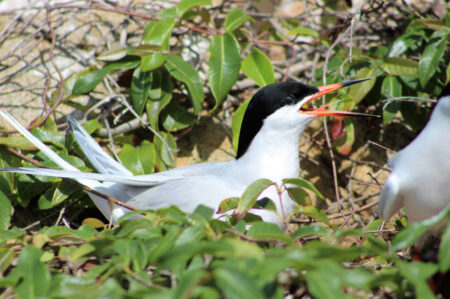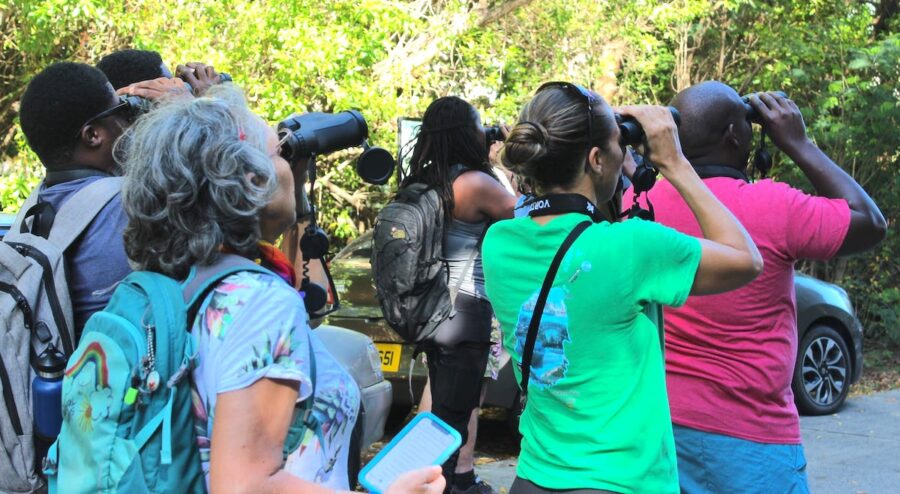BirdsCaribbean brings you highlights from the Journal of Caribbean Ornithology in our feature “Just Published in JCO.” Here, Zoya Buckmire, the Lead Copy Editor for the Journal of Caribbean Ornithology, explores the innovative methods Caribbean researchers are using to overcome the challenges of monitoring bird populations.

Long-term monitoring of bird populations would be a breeze if scientists had unlimited time and money. In the real world, however, monitoring efforts are limited by funding, access, trained personnel, and time. This is the case throughout the Caribbean, especially on the more remote islands and cays. So how do we navigate these many challenges to collect the critical information we need to manage and conserve our bird populations? In three papers recently published in Volume 36 of the Journal of Caribbean Ornithology, researchers across the region explore our options—from synthesizing historical data to exploring new technologies, to maximizing the power of citizen science!
The value in historical surveys
Quality bird survey data is worth its weight in gold, but surveys conducted over different periods with different objectives and priorities can be difficult to compare. Nevertheless, these comparisons are necessary to identify trends in populations. Where consistent long-term monitoring data are lacking, it is possible to compare even a single season’s worth of historical data with current surveys to approximate trends.
This is precisely what Dr. Paige Byerly and her colleagues did with seabird data from the Virgin Islands, a region which is critical for breeding seabirds in the Caribbean. In their article “Current status and 21st century population trends of breeding seabirds in the U.S. and British Virgin Islands,” the researchers focused on seven species of seabirds (boobies, terns, and pelicans) known to breed in the archipelago, and compared data from the early 2000s with their own surveys conducted in 2016-2018. Whilst the population trends they found were dismaying, they were incredibly timely and necessary for the effective management of these birds and their breeding sites. Paige and colleagues demonstrate here that it is not impossible to form a cohesive picture from various disparate surveys over time—thus highlighting one way to make the most of the limited data available in the Caribbean.
New technologies for monitoring
The logistical problems of access and funding for surveys are compounded on the remote cays that are preferred by seabirds. A few miles east of the Virgin Islands, in Anguilla, the National Trust has been exploring their options to increase the efficiency of their monitoring efforts. Passive acoustic monitoring (PAM) is an emerging tool that uses recording units and automated species recognition software to identify the birds present at a site. In 2020, Dr. Louise Soanes and her former colleagues at the Anguilla National Trust launched a pilot project to test the utility of this tool in the Caribbean context. By deploying recording units at several study sites and ground-truthing with regular point counts, they were able to compare the accuracy and effectiveness of PAM to more traditional point counting.
PAM is not without its kinks, of course, as species recognition software is not yet well developed for Caribbean birds (and their many dialects), which leads to many misidentifications. However, with time and additions to the database (which you can contribute to!), these automated identifications will improve. In their paper “Passive acoustic monitoring of birds in the Lesser Antilles—a useful tool for monitoring remote sites?”, Louise and colleagues describe these results and present recommendations for the best use of PAM throughout the region. With further testing and more widespread implementation, this tool has the potential to significantly increase the efficiency of monitoring, especially in remote and hard-to-access areas, and can support the establishment of more long-term monitoring programs in the region.
Dr. Soanes is also the Seabird Census Coordinator for the BirdsCaribbean Seabird Working Group, which recently shared preliminary results from the first-ever Caribbean Seabird Census in a webinar you can watch here!
Making the most of citizen science
Citizen science data, like eBird records and community-mobilized surveys, provide a seemingly obvious solution to the various logistical and resource challenges of data collection in the Caribbean, but using these data comes with its own challenges. Because survey methods are unstandardized and user experience can vary greatly, from novice and casual birders to trained ornithologists, citizen science data must be taken—and analyzed—with a grain of salt. Some questions to consider are: how does observer experience affect detectability of birds in the field? And do observers perform differently depending on survey design (single- or double-observer) and who they are paired with? To answer these questions and more, graduate student Nicholas Bergen conducted his thesis research in Grenada using a citizen science experiment.
Detailed in their article “Effects of observer skill and survey method on forest bird abundance data: recommendations for citizen science conservation monitoring in the Caribbean,” Nicholas and colleagues involved 34 different observers (myself included!) in over 400 surveys across the island. By pairing observers of different skill levels and conducting both point-count and transect surveys, they were able to identify the most efficient survey type for citizen scientists (spoiler alert: it was point counts) and draw correlations between observer skill level and the detectability of different species. The authors provide several practical recommendations for the design and implementation of citizen science-based monitoring programs in the region including ideal timing, protocols, and observer pairings for the surveys.

However, you do not have to create your own citizen science programs from scratch! eBird is an incredible but underutilized resource in the Caribbean. Millions of observations from around the world and thousands of checklists from the Caribbean have been verified by Cornell Lab and uploaded to the database. The Cornell Lab of Ornithology, creator and maintainer of the eBird database, has produced a comprehensive guide to the use of eBird data, including accounting for its various biases. With these challenges in mind, it is a goldmine of observations that can tell us lots about understudied areas and islands in the region, from “recording” new (previously unreported) species to identifying trends of decline. A few years ago, in our Volume 33, Ruby Bagwyn et al. used eBird data from The Bahamas to identify over 40 bird populations that had not been recorded over an 8-year period, highlighting the areas and species most in need of updated surveys. They suggested that we should use eBird to harness “the observational power of birdwatchers…to provide timely notice of declining or missing populations,” and spur us into action to prevent their extinction or extirpation.
These three examples from Volume 36 are just a sample of the incredible and innovative work being done across the Caribbean by researchers invested in our birds and their wellbeing. BirdsCaribbean is continually supporting monitoring in the region by adding to the skill sets and knowledge of Caribbean researchers through our capacity building efforts, including through our Seabird Working Group, Caribbean Waterbird Census program, Landbird Monitoring Network, and Caribbean Bird Banding Network. You can support our efforts to equip Caribbean nationals with the skills and resources they need to protect the region’s endemic, resident, and migratory birds here.
The Journal of Caribbean Ornithology is a peer-reviewed journal covering all aspects of ornithology within the Caribbean region, publishing in English, Spanish, and French. We welcome manuscripts covering the biology, ecology, behavior, life history, and conservation of Caribbean birds and their habitats. The JCO also publishes conservation reports and mentors inexperienced authors to help them develop their manuscript for publication. The JCO relies on donations to keep all of our publications free and open-access. Support our non-profit mission and give a voice to Caribbean ornithologists and their work by becoming a supporter of JCO.







